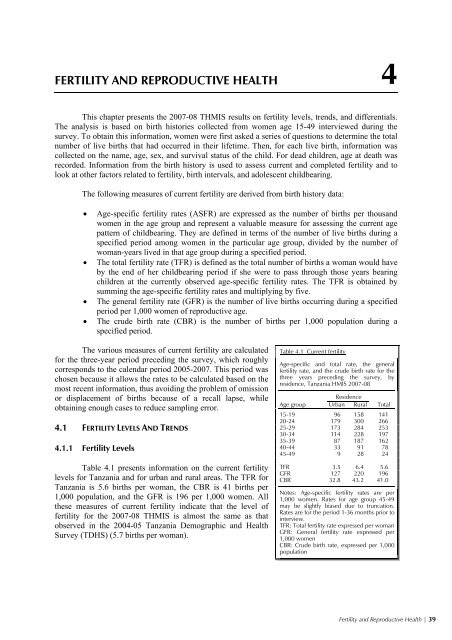Tanzania HIV/AIDS and Malaria Indicator Survey ... - Measure DHS
Tanzania HIV/AIDS and Malaria Indicator Survey ... - Measure DHS
Tanzania HIV/AIDS and Malaria Indicator Survey ... - Measure DHS
- No tags were found...
Create successful ePaper yourself
Turn your PDF publications into a flip-book with our unique Google optimized e-Paper software.
FERTILITY AND REPRODUCTIVE HEALTH 4This chapter presents the 2007-08 THMIS results on fertility levels, trends, <strong>and</strong> differentials.The analysis is based on birth histories collected from women age 15-49 interviewed during thesurvey. To obtain this information, women were first asked a series of questions to determine the totalnumber of live births that had occurred in their lifetime. Then, for each live birth, information wascollected on the name, age, sex, <strong>and</strong> survival status of the child. For dead children, age at death wasrecorded. Information from the birth history is used to assess current <strong>and</strong> completed fertility <strong>and</strong> tolook at other factors related to fertility, birth intervals, <strong>and</strong> adolescent childbearing.The following measures of current fertility are derived from birth history data:Age-specific fertility rates (ASFR) are expressed as the number of births per thous<strong>and</strong>women in the age group <strong>and</strong> represent a valuable measure for assessing the current agepattern of childbearing. They are defined in terms of the number of live births during aspecified period among women in the particular age group, divided by the number ofwoman-years lived in that age group during a specified period.The total fertility rate (TFR) is defined as the total number of births a woman would haveby the end of her childbearing period if she were to pass through those years bearingchildren at the currently observed age-specific fertility rates. The TFR is obtained bysumming the age-specific fertility rates <strong>and</strong> multiplying by five.The general fertility rate (GFR) is the number of live births occurring during a specifiedperiod per 1,000 women of reproductive age.The crude birth rate (CBR) is the number of births per 1,000 population during aspecified period.The various measures of current fertility are calculatedfor the three-year period preceding the survey, which roughlycorresponds to the calendar period 2005-2007. This period waschosen because it allows the rates to be calculated based on themost recent information, thus avoiding the problem of omissionor displacement of births because of a recall lapse, whileobtaining enough cases to reduce sampling error.4.1 FERTILITY LEVELS AND TRENDS4.1.1 Fertility LevelsTable 4.1 presents information on the current fertilitylevels for <strong>Tanzania</strong> <strong>and</strong> for urban <strong>and</strong> rural areas. The TFR for<strong>Tanzania</strong> is 5.6 births per woman, the CBR is 41 births per1,000 population, <strong>and</strong> the GFR is 196 per 1,000 women. Allthese measures of current fertility indicate that the level offertility for the 2007-08 THMIS is almost the same as thatobserved in the 2004-05 <strong>Tanzania</strong> Demographic <strong>and</strong> Health<strong>Survey</strong> (T<strong>DHS</strong>) (5.7 births per woman).Table 4.1 Current fertilityAge-specific <strong>and</strong> total rate, the generalfertility rate, <strong>and</strong> the crude birth rate for thethree years preceding the survey, byresidence, <strong>Tanzania</strong> HMIS 2007-08ResidenceAge group Urban Rural Total15-19 96 158 14120-24 179 300 26625-29 173 284 25330-34 114 228 19735-39 87 187 16240-44 33 91 7845-49 9 28 24TFR 3.5 6.4 5.6GFR 127 220 196CBR 32.8 43.2 41.0Notes: Age-specific fertility rates are per1,000 women. Rates for age group 45-49may be slightly biased due to truncation.Rates are for the period 1-36 months prior tointerview.TFR: Total fertility rate expressed per womanGFR: General fertility rate expressed per1,000 womenCBR: Crude birth rate, expressed per 1,000populationFertility <strong>and</strong> Reproductive Health | 39








![Obtaining Informed Consent for HIV Testing [QRS4] - Measure DHS](https://img.yumpu.com/49850117/1/190x245/obtaining-informed-consent-for-hiv-testing-qrs4-measure-dhs.jpg?quality=85)







